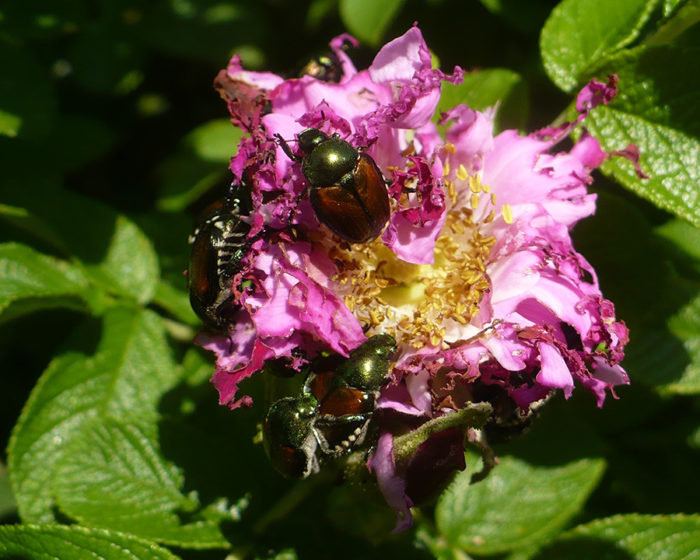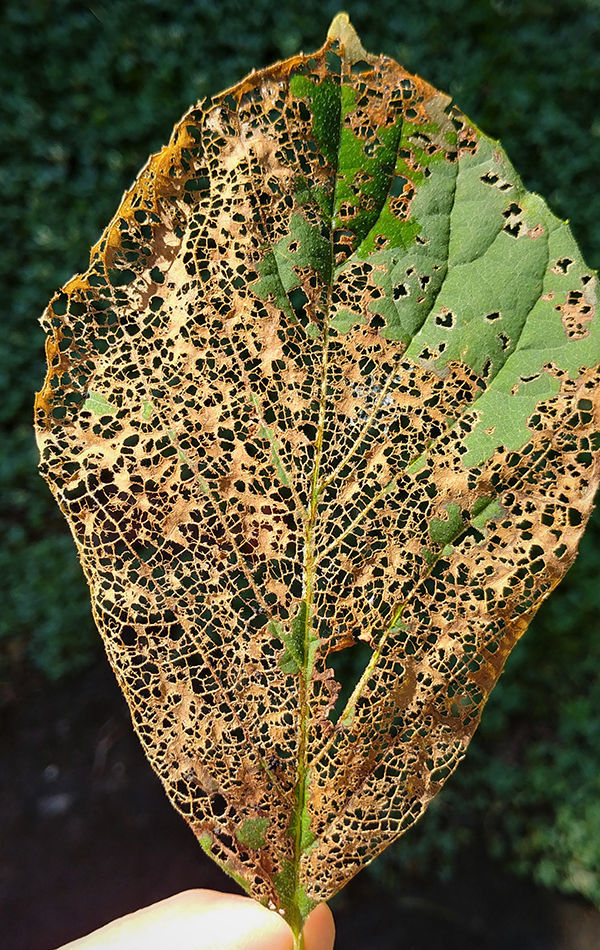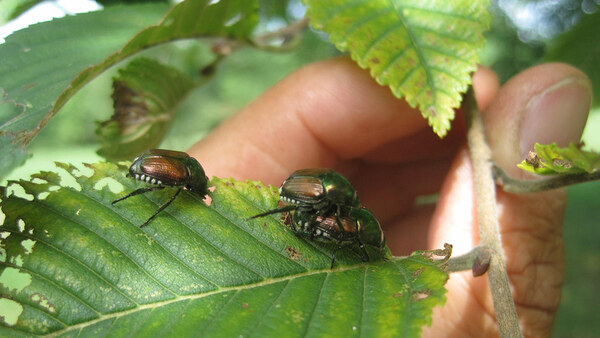
When summer begins in your garden, whether on the patio or in the landscape, an ecosystem of living organisms brings insects to the front and center. The appearance of Japanese beetles (Popillia japonica) marks the month of June in the upper Southeast. With the beetles come the conversations: “Will they be bad this year?,” “Don’t bother with the traps, you know,” “I think I’m just going to get rid of my roses if I have to look at one more beetle orgy ruining my blooms!”
Take a closer look
You may already be more familiar than you would like to be with the Japanese beetle, an accidentally introduced pest that is now a permanent resident in the eastern and midwestern United States. Japanese beetles are a species of Asian scarab beetles, about half an inch long with metallic green heads and bodies, coppery wing shields, and six short white hairs along their sides. Those white hairs, along with a slightly smaller size, distinguish Japanese beetles from June bugs, our other common metallic green summer beetle. June bugs are native to eastern North America and are especially abundant in the South.
Japanese beetles devour flowers and skeletonize leaves, eating all the green tissue and leaving only a lacy network of veins in the shape of a leaf. It’s worth remembering that while adult beetles leave ugly foliage and ruined flowers in their wake, they are not a devastating pest—they won’t kill your plants.
The adult Japanese beetles are active for only four to six weeks each year. Scout for their emergence by checking their favorite plants, which include roses (Rosa spp. and cvs., Zones 3–9), mallows (Malva spp. and cvs., Zones 3–8), beans, grapes, crape myrtles (Lagerstroemia indica, Zones 7–9), and Japanese maples (Acer palmatum, Zones 5–9). Chances are you’ve seen them in their larval stage as well. The white grubs are frequently unearthed when planting in spring or fall. The larvae live underground in late summer through the following spring, feeding on grass roots. If populations become exceptionally high, larvae may leave dead patches of turf.

Predicting this summer’s beetle storm
Predictions are just that, but drought is the single most limiting environmental factor for larval survival. The drier the previous year, the fewer Japanese beetles come June. After emerging from the soil, adults are drawn to their favorite food plants, and males are drawn to the females. Their activities—eating and mating—are influenced by local weather. Feeding levels and the amount of flying is increased by bright sunshine and humidity levels over 60%. A rainy, cloudy, windy June may put a damper on their parties, resulting in fewer offspring to become next year’s adults.
Damage control
Because the beetles are not a significant threat to the health of your plants—as much as you may curse them—keep the health of your garden ecosystem in mind as you choose control methods. Here are my recommendations:
- Go beetle pickin’. With soapy-water-filled bucket in hand, take 15 minutes each morning to gently scoop the beetles from favorite plants, then fling them into the soapy water. Empty the bucket-o-beetles after they’ve expired.
- Don’t be lured by the traps. Japanese beetle traps are sold as a control method, but they are best used only as a way to monitor levels. They contain a pheromone that draw in beetles from a surprising distance. The problem is that many do not end up in the trap. Instead, they are now in your yard and will go straight for their favorite foods. Additionally, the beetles that do die in the traps give off odors that repel live beetles from the trap.
- Change their food. If you are particularly disgusted with these pests, avoid adding or even replacing their favorite food plants in your garden. Learn more about their plant likes and dislikes from this Mississippi State study.
- Use natural repellants. Some degree of control can be achieved using a natural bacteria called milky spore (Paenibacillus popilliae) or parasitic nematodes (Heterorhabditis bacteriphora). Consult your local extension service for specific recommendations, as they will vary depending on your soils.
- Resist insecticides. I prefer to save my limited use of insecticides for devastating pests, but if you decide to go this route, do not use sprays or powders directly on flowers. The insecticides that kill adult beetles are not specific and will kill the bees and butterflies visiting those flowers as indiscriminately as the beetles you are targeting.
—Paula Gross is the former assistant director of the University of North Carolina at Charlotte Botanical Gardens.


















Comments
Log in or create an account to post a comment.
Sign up Log in